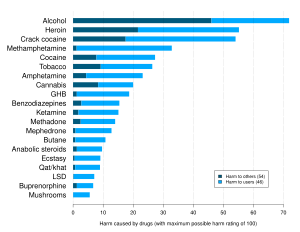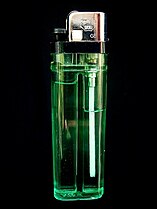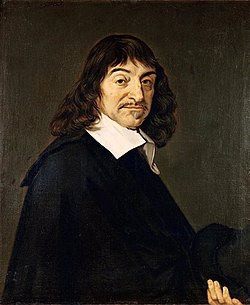| |||
| |||
| Names | |||
|---|---|---|---|
| Preferred IUPAC name
Butane | |||
| Systematic IUPAC name
Tetracarbane (never recommended) | |||
Other names
| |||
| Identifiers | |||
3D model (JSmol)
|
|||
| 969129 | |||
| ChEBI | |||
| ChEMBL | |||
| ChemSpider | |||
| ECHA InfoCard | 100.003.136 | ||
| EC Number |
| ||
| E number | E943a (glazing agents, ...) | ||
| 1148 | |||
| KEGG | |||
| MeSH | butane | ||
PubChem CID
|
|||
| RTECS number |
| ||
| UNII | |||
| UN number | 1011 | ||
CompTox Dashboard (EPA)
|
|||
| Properties | |
|---|---|
| C4H10 | |
| Molar mass | 58.124 g·mol−1 |
| Appearance | Colorless gas |
| Odor | Gasoline-like or natural gas-like |
| Density | 2.48 kg/m3 (at 15 °C (59 °F)) |
| Melting point | −140 to −134 °C; −220 to −209 °F; 133 to 139 K |
| Boiling point | −1 to 1 °C; 30 to 34 °F; 272 to 274 K |
| 61 mg/L (at 20 °C (68 °F)) | |
| log P | 2.745 |
| Vapor pressure | ~170 kPa at 283 K |
Henry's law
constant (kH) |
11 nmol Pa−1 kg−1 |
| −57.4·10−6 cm3/mol | |
| Thermochemistry | |
Heat capacity (C)
|
98.49 J/(K·mol) |
Std enthalpy of
formation (ΔfH⦵298) |
−126.3–−124.9 kJ/mol |
Std enthalpy of
combustion (ΔcH⦵298) |
−2.8781–−2.8769 MJ/mol |
| Hazards | |
| GHS labelling: | |
 
| |
| Danger | |
| H220 | |
| P210 | |
| NFPA 704 (fire diamond) | |
| Flash point | −60 °C (−76 °F; 213 K) |
| 405 °C (761 °F; 678 K) | |
| Explosive limits | 1.8–8.4% |
| NIOSH (US health exposure limits): | |
PEL (Permissible)
|
none |
REL (Recommended)
|
TWA 800 ppm (1900 mg/m3) |
IDLH (Immediate danger)
|
1600 ppm |
| Related compounds | |
Related alkanes
|
|
Related compounds
|
Perfluorobutane |
| Supplementary data page | |
| Butane (data page) | |
Except where otherwise noted, data are given for materials in their standard state (at 25 °C [77 °F], 100 kPa).
| |
Butane (/ˈbjuːteɪn/) or n-butane is an alkane with the formula C4H10. Butane is a highly flammable, colorless, easily liquefied gas that quickly vaporizes at room temperature and pressure. The name butane comes from the root but- (from butyric acid, named after the Greek word for butter) and the suffix -ane. It was discovered in crude petroleum in 1864 by Edmund Ronalds, who was the first to describe its properties, and commercialized by Walter O. Snelling in the early 1910s.
Butane is one of a group of liquefied petroleum gases (LP gases). The others include propane, propylene, butadiene, butylene, isobutylene, and mixtures thereof. Butane burns more cleanly than both gasoline and coal.
History
The first synthesis of butane was accidentally achieved by British chemist Edward Frankland in 1849 from ethyl iodide and zinc, but he had not realized that the ethyl radical dimerized and misidentified the substance.
Edmund Ronalds was the first individual to isolate and describe butane, which he named "hydride of butyl," based on the naming for the then-known butyric acid, which had been named and described by the French chemist Michel Eugène Chevreul 40 years earlier. Other names arose in the 1860s: "butyl hydride", "hydride of tetryl" and "tetryl hydride", "diethyl" or "ethyl ethylide" and others. August Wilhelm von Hofmann, in his 1866 systemic nomenclature, proposed the name "quartane", and the modern name was introduced to English from German around 1874.
Butane did not have much practical use until the 1910s, when W. Snelling identified butane and propane as components in gasoline and found that, if they were cooled, they could be stored in a volume-reduced liquified state in pressurized containers. In 1911, Snelling's liquified petroleum gas was publicly available, and his process for producing the mixture was patented in 1913. Butane is one of the most produced industrial chemicals in the 21st century with around 80-90 billion lbs (40 million US tons, 36 million metric tons) produced by the United States every year.
Density
The density of butane is highly dependent on temperature and pressure in the reservoir. For example, the density of liquid butane is 571.8±1 kg/m3 (for pressures up to 2MPa and temperature 27±0.2 °C), while the density of liquid butane is 625.5±0.7 kg/m3 (for pressures up to 2MPa and temperature -13±0.2 °C).
Isomers
| Common name | normal butane unbranched butane n-butane |
isobutane i-butane |
| IUPAC name | butane | methylpropane |
| Molecular diagram |

|

|
| Skeletal diagram |

|
Rotation about the central C−C bond produces two different conformations (trans and gauche) for n-butane.
Reactions

When oxygen is plentiful, butane burns to form carbon dioxide and water vapor; when oxygen is limited, carbon (soot) or carbon monoxide may also be formed. Butane is denser than air.
When there is sufficient oxygen:
- 2 C4H10 + 13 O2 → 8 CO2 + 10 H2O
When oxygen is limited:
- 2 C4H10 + 9 O2 → 8 CO + 10 H2O
By weight, butane contains about 49.5 MJ/kg (13.8 kWh/kg; 22.5 MJ/lb; 21,300 Btu/lb) or by liquid volume 29.7 megajoules per liter (8.3 kWh/L; 112 MJ/U.S. gal; 107,000 Btu/U.S. gal).
The maximum adiabatic flame temperature of butane with air is 2,243 K (1,970 °C; 3,578 °F).
n-Butane is the feedstock for DuPont's catalytic process for the preparation of maleic anhydride:
- 2 CH3CH2CH2CH3 + 7 O2 → 2 C2H2(CO)2O + 8 H2O
n-Butane, like all hydrocarbons, undergoes free radical chlorination providing both 1-chloro- and 2-chlorobutanes, as well as more highly chlorinated derivatives. The relative rates of the chlorination is partially explained by the differing bond dissociation energies, 425 and 411 kJ/mol for the two types of C-H bonds.
Uses
Normal butane can be used for gasoline blending, as a fuel gas, fragrance extraction solvent, either alone or in a mixture with propane, and as a feedstock for the manufacture of ethylene and butadiene, a key ingredient of synthetic rubber. Isobutane is primarily used by refineries to enhance (increase) the octane number of motor gasoline.
For gasoline blending, n-butane is the main component used to manipulate the Reid vapor pressure (RVP). Since winter fuels require much higher vapor pressure for engines to start, refineries raise the RVP by blending more butane into the fuel. n-Butane has a relatively high research octane number (RON) and motor octane number (MON), which are 93 and 92 respectively.
When blended with propane and other hydrocarbons, the mixture may be referred to commercially as liquefied petroleum gas (LPG). It is used as a petrol component, as a feedstock for the production of base petrochemicals in steam cracking, as fuel for cigarette lighters and as a propellant in aerosol sprays such as deodorants.
Pure forms of butane, especially isobutane, are used as refrigerants and have largely replaced the ozone-layer-depleting halomethanes in refrigerators, freezers, and air conditioning systems. The operating pressure for butane is lower than for the halomethanes such as Freon-12 (R-12), so R-12 systems such as those in automotive air conditioning systems, when converted to pure butane, will function poorly. A mixture of isobutane and propane is used instead to give cooling system performance comparable to use of R-12.
Butane is also used as lighter fuel for common lighters or butane torches and is sold bottled as a fuel for cooking, barbecues and camping stoves. In the 20th century the Braun company of Germany made a cordless hair styling device product that used butane as its heat source to produce steam.
As fuel, it is often mixed with small amounts of mercaptans to give the unburned gas an offensive smell easily detected by the human nose. In this way, butane leaks can easily be identified. While hydrogen sulfide and mercaptans are toxic, they are present in levels so low that suffocation and fire hazard by the butane becomes a concern far before toxicity. Most commercially available butane also contains some contaminant oil, which can be removed by filtration and will otherwise leave a deposit at the point of ignition and may eventually block the uniform flow of gas.
The butane used as a solvent for fragrance extraction does not contain these contaminants and butane gas can cause gas explosions in poorly ventilated areas if leaks go unnoticed and are ignited by spark or flame. Purified butane is used as a solvent in the industrial extraction of cannabis oils.
-
Butane fuel canisters for use in camping stoves
-
Butane lighter, showing liquid butane reservoir
-
An aerosol spray can, which may be using butane as a propellant
-
Butane gas cylinder used for cooking
Effects and health issues

Inhalation of butane can cause euphoria, drowsiness, unconsciousness, asphyxia, cardiac arrhythmia, fluctuations in blood pressure and temporary memory loss, when abused directly from a highly pressurized container, and can result in death from asphyxiation and ventricular fibrillation. It enters the blood supply and within seconds produces intoxication. Butane is the most commonly abused volatile substance in the UK, and was the cause of 52% of solvent related deaths in 2000. By spraying butane directly into the throat, the jet of fluid can cool rapidly to −20 °C (−4 °F) by expansion, causing prolonged laryngospasm. "Sudden sniffer's death" syndrome, first described by Bass in 1970, is the most common single cause of solvent related death, resulting in 55% of known fatal cases.









